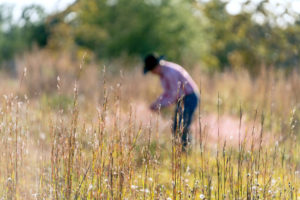AgriLife Extension bolsters habitat expertise with new rangeland specialist
Extension, research directed at economic and ecological sustainability for landowners
A new rangeland specialist is available to ranchers and landowners in South Texas looking for science-based solutions to ecosystem and rangeland management challenges.

Stacy Hines, Ph.D., was recently hired as the new rangeland habitat management specialist for Texas A&M AgriLife Extension Service and assistant professor in the Texas A&M Department of Rangeland, Wildlife and Fisheries Management.
Hines will be based at the Texas A&M AgriLife Research and Extension Center in Corpus Christi. Her research will focus on the varied interconnection between rangelands, the native, improved and invasive plant species in them, and the livestock and wildlife they support.
Her dissertation research at the Caesar Kleberg Wildlife Research Institute at the Texas A&M University-Kingsville focused on cattle, deer and nilgai interactions and impacts on rangelands in South Texas on East Foundation ranches. Her current research interests include restoration of native Texas grasslands, conservation grazing, and effective and economical methods for rangeland habitat management.
Hines said she is excited to be back in South Texas and in a position to help ranchers and landowners manage natural resources.
“I fell in love with habitat management and understanding the impacts that livestock and large herbivores have on our vegetation,” she said. “This was an opportunity for me to come back and facilitate the habitat management needs here in South Texas and help our ranchers apply science-based practices to their land in economically and ecologically sustainable ways.”
Hines fill the position left when Megan Clayton, Ph.D., AgriLife Extension rangeland specialist, transferred to the Texas A&M AgriLife Research and Extension Center in Uvalde.
Rangeland specialist brings planning, solutions
Parr Rosson, Ph.D., associate department head for AgriLife Extension in the Department of Rangeland, Wildlife and Fisheries Management, said adding a new rangeland specialist was a critical step to bolster the agency’s ability to help Texans manage natural resources they steward as landowners.
“Landowners view their properties according to how they utilize the land and the available natural resources within it,” he said. “AgriLife Extension plays an integral role in providing expertise to help landowners integrate management practices designed to meet their goals. Rangelands are tied to a big part of what we do and the Texans we serve.”
Hines said she is eager to serve landowners across the spectrum of property acres and goals, whether conservation or agriculture and wildlife production.
Many ranches in South Texas are multi-functional operations that create income through livestock and wildlife, she said. Providing planning around the economic value of an operation’s resources is part of the holistic view to rangeland management Hines believes sustains the land, wildlife and business aspects of ranching.
She hopes to help guide ranchers and landowners through challenges like weather variability and invasive plant encroachment. Land fragmentation and land repurposing are also changing the South Texas landscape, and Hines said she is familiar with the challenges and opportunities new landowners and established production operations face as it changes.
“There are a lot of challenges for the ecosystems and the ranchers who depend on the land for their livelihoods,” she said. “New landowners and land use changes are part of that, but with that comes a great opportunity to engage with landowners and stakeholders who have a vested interest in improving the land in a way that enhances biodiversity and production and sustains the resources.”
Encroaching plants like mesquite that impact livestock production continue to be a challenge for landowners, Hines said. Understanding contributing factors like overgrazing, climactic variables and soil disruption and how various management options can be deployed against brush encroachment all play a role in providing solutions for landowners.
Weather is highly variable in South Texas with extended droughts and above-average rainfall changing month to month and year to year, she said. Preparing producers for drought and climactic conditions that can impact grazing and wildlife habitat will be another focus.
Hines said the correlations between rainfall and native vegetation, or improved pasture growth and stocking rates are a good example of how research data can forecast outcomes and inform decision making.
“We want research to help us create a prescription plan that landowners and ranchers can follow in a way that gives them flexibility to adjust to weather variability,” she said. “That starts with making correlations between factors like weather and production and giving them recommendations based on a range scenario. We need to understand what is going on today and how it impacts management decisions on stocking rates and wildlife into the future.”
Short-term goals and background
Hines is working to address the top question AgriLife Extension agents get – “What is this plant, and how do I control it?”

She is looking to improve plant identification resources available to agents and the public because identification is the basis for any management decision of the plant. Hines hopes to create a plant identification application that can provide good information on regional plant species in a variety of growth stages.
Hines said most plant identification applications typically focus on how the plant presents at flowering. This is problematic in the case of invasive plants because they are harder to treat long-term once they set seed heads.
“Plant identification is the key to understanding the benefits or negatives of a plant and the different management aspects of controlling it,” she said. “Some plants may be viewed by a rancher as a pest weed, but their view might be contrary to their production goals if that plant is a native species that supports wildlife like quail. That goes back to correlation and how management decisions may help or hinder a landowner from maximizing their idea of resource productivity. We want to help them toward their goals.”
Hines earned a bachelor’s degree in environmental studies and parks and recreation management at the University of North Carolina-Wilmington, a master’s degree in biology from the University of North Carolina-Greensboro and a doctorate in wildlife science from Texas A&M University at Kingsville.
She worked for state agencies, including the North Carolina Division of Parks and Recreation and North Carolina Wildlife Resources Commission and is a certified environmental educator. She has 10 years’ collective experience in higher education in which she instructed more than 13 courses in seven subject areas. Prior to taking the position with AgriLife Extension, Hines developed a new, online master of science in conservation education degree program for Mississippi State University.
“I joined AgriLife Extension so that I could serve our Texas landowners and stakeholders,” Hines said. “I count it as a privilege to communicate sound science to our stakeholders, so they will have the best information to guide the sustainable management of our Texas rangelands.”


